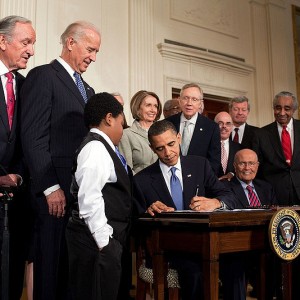 Are the current personnel cuts the beginning of the end for the U.S. Marines? Could these actually be the last days of the U.S. Marine Corps? A decade ago, such a notion would have been absolutely unthinkable, but times have changed. The Marine Corps was already in the process of drawing down from a peak of 202,100 Marines to 182,100, and now Defense Secretary Chuck Hagel is warning that the sequester cuts may force the Army to be cut down to a size of 380,000 and the Marine Corps to be cut down to a size of 150,000. Unfortunately for the Marines, even larger cuts may eventually be coming. Many in the Obama administration and in the Pentagon are now openly questioning whether there will be an important role for the Marines to play in the future. After all, the U.S. military has not conducted a major amphibious landing since the Korean War. As our politicians look for even more ways to cut military expenses in the years ahead, the Marines may end up being very tempting “low hanging fruit” that the bureaucrats can’t resist. And unless another major conflict erupts, it seems clear that more cuts are probably coming. In fact, even the New York Times admits that “deep reductions” to the U.S. military have long been an important goal for Barack Obama. (Read More...)
Are the current personnel cuts the beginning of the end for the U.S. Marines? Could these actually be the last days of the U.S. Marine Corps? A decade ago, such a notion would have been absolutely unthinkable, but times have changed. The Marine Corps was already in the process of drawing down from a peak of 202,100 Marines to 182,100, and now Defense Secretary Chuck Hagel is warning that the sequester cuts may force the Army to be cut down to a size of 380,000 and the Marine Corps to be cut down to a size of 150,000. Unfortunately for the Marines, even larger cuts may eventually be coming. Many in the Obama administration and in the Pentagon are now openly questioning whether there will be an important role for the Marines to play in the future. After all, the U.S. military has not conducted a major amphibious landing since the Korean War. As our politicians look for even more ways to cut military expenses in the years ahead, the Marines may end up being very tempting “low hanging fruit” that the bureaucrats can’t resist. And unless another major conflict erupts, it seems clear that more cuts are probably coming. In fact, even the New York Times admits that “deep reductions” to the U.S. military have long been an important goal for Barack Obama. (Read More...)
A Quadrillion Yen And Counting – The Japanese Debt Bomb Could Set Off Global Panic At Any Moment
 How much is 1,000,000,000,000,000 yen worth? Well, a quadrillion yen is worth approximately 10.5 trillion dollars. It is an amount of money that is larger than the “the economies of Germany, France and the U.K. combined“. It is such an astounding amount of debt that it is hard to even get your mind around it. The government debt to GDP ratio in Japan will reach 247 percent this year, and the Japanese currently spend about 50 percent of all central government tax revenue on debt service. Realistically, there are only two ways out of this overwhelming debt trap for the Japanese. Either they default or they try to inflate the debt away. At this point, the Japanese have chosen to try to inflate the debt away. They have initiated the greatest quantitative easing experiment that a major industrialized nation has attempted since the days of the Weimar Republic. Over the next two years, the Bank of Japan plans to zap 60 trillion yen into existence out of thin air and use it to buy government bonds. By the time this program is over, the monetary base in Japan will have approximately doubled. But authorities in Japan are desperate. They know that the Japanese debt bomb could set off global panic at any time, and they are trying to find a way out that will not cause too much pain. (Read More...)
How much is 1,000,000,000,000,000 yen worth? Well, a quadrillion yen is worth approximately 10.5 trillion dollars. It is an amount of money that is larger than the “the economies of Germany, France and the U.K. combined“. It is such an astounding amount of debt that it is hard to even get your mind around it. The government debt to GDP ratio in Japan will reach 247 percent this year, and the Japanese currently spend about 50 percent of all central government tax revenue on debt service. Realistically, there are only two ways out of this overwhelming debt trap for the Japanese. Either they default or they try to inflate the debt away. At this point, the Japanese have chosen to try to inflate the debt away. They have initiated the greatest quantitative easing experiment that a major industrialized nation has attempted since the days of the Weimar Republic. Over the next two years, the Bank of Japan plans to zap 60 trillion yen into existence out of thin air and use it to buy government bonds. By the time this program is over, the monetary base in Japan will have approximately doubled. But authorities in Japan are desperate. They know that the Japanese debt bomb could set off global panic at any time, and they are trying to find a way out that will not cause too much pain. (Read More...)
During The Best Period Of Economic Growth In U.S. History There Was No Income Tax And No Federal Reserve
 How would America ever survive without the central planners in the Obama administration and at the Federal Reserve? What in the world would we do if there was no income tax and no IRS? Could the U.S. economy possibly keep from collapsing under such circumstances? The mainstream media would have us believe that unless we have someone “to pull the levers” our economy would descend into utter chaos, but the truth is that the best period of economic growth in U.S. history occurred during a time when there was no income tax and no Federal Reserve. Between the Civil War and 1913, the U.S. economy experienced absolutely explosive growth. The free market system thrived and the rest of the world looked at us with envy. The federal government was very limited in size, there was no income tax for most of that time and there was no central bank. To many Americans, it would be absolutely unthinkable to have such a society today, but it actually worked very, very well. Without the inventions and innovations that came out of that period, the world would be a far different place today. (Read More...)
How would America ever survive without the central planners in the Obama administration and at the Federal Reserve? What in the world would we do if there was no income tax and no IRS? Could the U.S. economy possibly keep from collapsing under such circumstances? The mainstream media would have us believe that unless we have someone “to pull the levers” our economy would descend into utter chaos, but the truth is that the best period of economic growth in U.S. history occurred during a time when there was no income tax and no Federal Reserve. Between the Civil War and 1913, the U.S. economy experienced absolutely explosive growth. The free market system thrived and the rest of the world looked at us with envy. The federal government was very limited in size, there was no income tax for most of that time and there was no central bank. To many Americans, it would be absolutely unthinkable to have such a society today, but it actually worked very, very well. Without the inventions and innovations that came out of that period, the world would be a far different place today. (Read More...)
The Rise Of The Bear: 18 Signs That Russia Is Rapidly Catching Up To The United States
 The Russian Bear is stronger and more powerful than it has ever been before. Sadly, most Americans don’t understand this. They still think of Russia as an “ex-superpower” that was rendered almost irrelevant when the Cold War ended. And yes, when the Cold War ended Russia was in rough shape. I got the chance to go over there in the early nineties, and at the time Russia was an economic disaster zone. Russian currency was so worthless that I joked that I could go exchange a 20 dollar bill and buy the Kremlin. But since that time Russia has roared back to life. Once Vladimir Putin became president, the Russian economy started to grow very rapidly. Today, Russia is an economic powerhouse that is blessed with an abundance of natural resources. Their debt to GDP ratio is extremely small, they actually run a trade surplus every year, and they have the second most powerful military on the entire planet. Anyone that underestimates Russia at this point is making a huge mistake. The Russian Bear is back, and today it is a more formidable adversary than it ever was at any point during the Cold War. (Read More...)
The Russian Bear is stronger and more powerful than it has ever been before. Sadly, most Americans don’t understand this. They still think of Russia as an “ex-superpower” that was rendered almost irrelevant when the Cold War ended. And yes, when the Cold War ended Russia was in rough shape. I got the chance to go over there in the early nineties, and at the time Russia was an economic disaster zone. Russian currency was so worthless that I joked that I could go exchange a 20 dollar bill and buy the Kremlin. But since that time Russia has roared back to life. Once Vladimir Putin became president, the Russian economy started to grow very rapidly. Today, Russia is an economic powerhouse that is blessed with an abundance of natural resources. Their debt to GDP ratio is extremely small, they actually run a trade surplus every year, and they have the second most powerful military on the entire planet. Anyone that underestimates Russia at this point is making a huge mistake. The Russian Bear is back, and today it is a more formidable adversary than it ever was at any point during the Cold War. (Read More...)
11 Examples Of The Escalating Crime And Violence That Are Plaguing Communities Across America
 Even though the United States has the highest incarceration rate and the largest total prison population in the world by a very wide margin, hundreds of communities all over America are being overwhelmed by crime and violence. For many years, violent crime had actually decreased in the United States, but now the trend is going the other way. Violent crime in the U.S. increased in both 2011 and 2012, and it is being projected that it will increase in 2013 as well. The frightening thing is that crime statistics are going up even though police departments in some major cities have publicly announced that they will not even respond to certain crimes anymore. This has the effect of making crime statistics look lower than they actually should be. For example, in the city of Chicago police will no longer respond in person “to 911 calls reporting vehicle theft, garage burglary or simple assault“. So if someone steals your car or breaks into your garage, you can file a report over the phone if you want, but it probably won’t do much good. (Read More...)
Even though the United States has the highest incarceration rate and the largest total prison population in the world by a very wide margin, hundreds of communities all over America are being overwhelmed by crime and violence. For many years, violent crime had actually decreased in the United States, but now the trend is going the other way. Violent crime in the U.S. increased in both 2011 and 2012, and it is being projected that it will increase in 2013 as well. The frightening thing is that crime statistics are going up even though police departments in some major cities have publicly announced that they will not even respond to certain crimes anymore. This has the effect of making crime statistics look lower than they actually should be. For example, in the city of Chicago police will no longer respond in person “to 911 calls reporting vehicle theft, garage burglary or simple assault“. So if someone steals your car or breaks into your garage, you can file a report over the phone if you want, but it probably won’t do much good. (Read More...)
Billionaire Issues Chilling Warning About Interest Rate Derivatives
 Will rapidly rising interest rates rip through the U.S. financial system like a giant lawnmower blade? Yes, the U.S. economy survived much higher interest rates in the past, but at that time there were not hundreds of trillions of dollars worth of interest rate derivatives hanging over our financial system like a Sword of Damocles. This is something that I have been talking about for quite some time, and now a Mexican billionaire has come forward with a similar warning. Hugo Salinas Price was the founder of the Elektra retail chain down in Mexico, and he is extremely concerned that rising interest rates could burst the derivatives bubble and cause “massive bankruptcies around the globe”. Of course there are a whole lot of people out there that would be quite glad to see the “too big to fail” banks go bankrupt, but the truth is that if they go down our entire economy will go down with them. Our situation is similar to a patient with a very advanced stage of cancer. You can try to kill the cancer with drugs, but you will almost certainly kill the patient at the same time. Well, that is essentially what our relationship with the big banks is like. Our entire economic system is based on credit, and just like we saw back in 2008, if the big banks start failing credit freezes up and suddenly nobody can get any money for anything. When the next great credit crunch comes, every important number in our economy will rapidly start getting much worse.
Will rapidly rising interest rates rip through the U.S. financial system like a giant lawnmower blade? Yes, the U.S. economy survived much higher interest rates in the past, but at that time there were not hundreds of trillions of dollars worth of interest rate derivatives hanging over our financial system like a Sword of Damocles. This is something that I have been talking about for quite some time, and now a Mexican billionaire has come forward with a similar warning. Hugo Salinas Price was the founder of the Elektra retail chain down in Mexico, and he is extremely concerned that rising interest rates could burst the derivatives bubble and cause “massive bankruptcies around the globe”. Of course there are a whole lot of people out there that would be quite glad to see the “too big to fail” banks go bankrupt, but the truth is that if they go down our entire economy will go down with them. Our situation is similar to a patient with a very advanced stage of cancer. You can try to kill the cancer with drugs, but you will almost certainly kill the patient at the same time. Well, that is essentially what our relationship with the big banks is like. Our entire economic system is based on credit, and just like we saw back in 2008, if the big banks start failing credit freezes up and suddenly nobody can get any money for anything. When the next great credit crunch comes, every important number in our economy will rapidly start getting much worse.
(Read More...)
40 Percent Of U.S. Workers Make Less Than What A Full-Time Minimum Wage Worker Made In 1968
 Are American workers paid enough? That is a topic that is endlessly debated all across this great land of ours. Unfortunately, what pretty much everyone can agree on is that American workers are not making as much as they used to after you account for inflation. Back in 1968, the minimum wage in the United States was $1.60 an hour. That sounds very small, but after you account for inflation a very different picture emerges. Using the inflation calculator that the Bureau of Labor Statistics provides, $1.60 in 1968 is equivalent to $10.74 today. And of course the official government inflation numbers have been heavily manipulated to make inflation look much lower than it actually is, so the number for today should actually be substantially higher than $10.74, but for purposes of this article we will use $10.74. If you were to work a full-time job at $10.74 an hour for a full year (with two weeks off for vacation), you would make about $21,480 for the year. That isn’t a lot of money, but according to the Social Security Administration, 40.28% of all workers make less than $20,000 a year in America today. So that means that more than 40 percent of all U.S. workers actually make less than what a full-time minimum wage worker made back in 1968. That is how far we have fallen. (Read More...)
Are American workers paid enough? That is a topic that is endlessly debated all across this great land of ours. Unfortunately, what pretty much everyone can agree on is that American workers are not making as much as they used to after you account for inflation. Back in 1968, the minimum wage in the United States was $1.60 an hour. That sounds very small, but after you account for inflation a very different picture emerges. Using the inflation calculator that the Bureau of Labor Statistics provides, $1.60 in 1968 is equivalent to $10.74 today. And of course the official government inflation numbers have been heavily manipulated to make inflation look much lower than it actually is, so the number for today should actually be substantially higher than $10.74, but for purposes of this article we will use $10.74. If you were to work a full-time job at $10.74 an hour for a full year (with two weeks off for vacation), you would make about $21,480 for the year. That isn’t a lot of money, but according to the Social Security Administration, 40.28% of all workers make less than $20,000 a year in America today. So that means that more than 40 percent of all U.S. workers actually make less than what a full-time minimum wage worker made back in 1968. That is how far we have fallen. (Read More...)
America: Where Hard Working, Productive Members Of Society Pay For The Health Care Of Everyone Else
 Everybody in America wants health care – but most Americans seem to want someone else to pay for it. In the United States today, the way that our system works is that the hard working, productive members of society pay for the health care of everyone else. At least under socialism everyone gets the same benefits. Our system of health care is a very twisted version of socialism where millions upon millions of very hard working people are forced to pay for the health care of others, but often can’t afford to purchase decent health insurance for themselves. Personally, I don’t have a big employer paying for my health care so I have to buy it myself, and I just got a letter from my health insurance company telling me that I have another massive rate increase coming up. Have you gotten a similar letter? Health insurance premiums are going up all over America, and this is just the beginning. In fact, the CEO of Aetna says that health insurance rates for many Americans will double when the major provisions of Obamacare kick in next year. (Read More...)
Everybody in America wants health care – but most Americans seem to want someone else to pay for it. In the United States today, the way that our system works is that the hard working, productive members of society pay for the health care of everyone else. At least under socialism everyone gets the same benefits. Our system of health care is a very twisted version of socialism where millions upon millions of very hard working people are forced to pay for the health care of others, but often can’t afford to purchase decent health insurance for themselves. Personally, I don’t have a big employer paying for my health care so I have to buy it myself, and I just got a letter from my health insurance company telling me that I have another massive rate increase coming up. Have you gotten a similar letter? Health insurance premiums are going up all over America, and this is just the beginning. In fact, the CEO of Aetna says that health insurance rates for many Americans will double when the major provisions of Obamacare kick in next year. (Read More...)